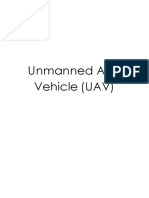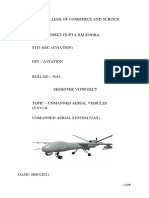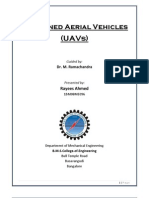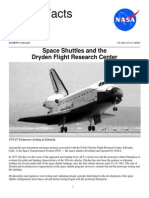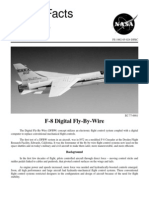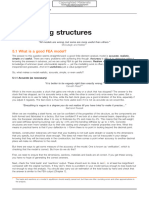Airport and Landing Aid Brief History
Airport and Landing Aid Brief History
Uploaded by
Ayman_Elmasry_9107Copyright:
Available Formats
Airport and Landing Aid Brief History
Airport and Landing Aid Brief History
Uploaded by
Ayman_Elmasry_9107Original Description:
Original Title
Copyright
Available Formats
Share this document
Did you find this document useful?
Is this content inappropriate?
Copyright:
Available Formats
Airport and Landing Aid Brief History
Airport and Landing Aid Brief History
Uploaded by
Ayman_Elmasry_9107Copyright:
Available Formats
Airport and landing aid brief history:
One of the most difficult tasks a pilot has to perform is to achieve a smooth and safe landing. Early pilots landed on an open field, facing any direction that gave them the best angle relative to the wind. But as traffic grew, and more aircraft began to use airports rather than farms or fields, landings became limited to certain directions. Landing aids were developed to help pilots find the correct landing course and to make landing safer. Airports had begun using lights in the late 1920s, when landing fields were marked with rotating lights so they could be found after dark. In the early 1930s, airports installed the earliest forms of approach lighting. These indicated the correct angle of descent and whether the pilot was right on target. Their approach path was called the glide path or glide slope. Gradually, the colors of the lights and their rates of flash became standard worldwide based on International Civil Aviation Organization (ICAO) standards. The Air Mail Service's intermediate, or emergency, landing fields that it established along the air route used rotating electric beacons and lights that were set around the perimeter of the field. The introduction of the slope-line approach system was a first in landing aids. Developed in the 1940s, the aid consisted of lights in rows that showed the pilot a simple funnel of two rows that led him to the end of the runway. Other patterns showed him when he was off to the right or left, or too high or low. The system was inexpensive to build and operate although it had some limitations and was not suitable for certain airports. Radio navigation aids also assisted in landing. One type, introduced in 1929, was the four-course radio range, where the pilot was guided by the strength of Morse code signals. Another type that was tried experimentally was the low-frequency radio beam. These radio beams flared outward from the landing point like a v, so at the point farthest from the runway, the beams were widely separated and it was easy for the pilot to fly between them. But near the landing point, the space between the beams was extremely narrow, and it was often easy for the pilot to miss the exact center point that he had to hit for landing. Another new method had a pilot tune into a certain frequency at a checkpoint far from the airport, and then uses a stopwatch to descend at a precise rate to the touchdown area of the runway. This method also proved difficult. The instrument landing system (ILS) incorporated the best features of both approach lighting and radio beacons with higher frequency transmissions. The ILS painted an electronic picture of the glide slope onto a pilot's cockpit instruments. Tests of the system began in 1929, and the Civil Aeronautics Administration (CAA) authorized installation of the system in 1941 at six locations. The first landing of a scheduled U.S. passenger airliner using ILS was on January 26, 1938, as a Pennsylvania-Central Airlines Boeing 247-D flew from Washington, D.C., to Pittsburgh and landed in a snowstorm using only the ILS system.
More than one type of ILS system was tried. The system eventually adopted consisted of a course indicator (called a localizer) that showed whether the plane was to the left or right of the runway centerline, a glide path or landing beam to show if the plane was above or below the glide slope, and two marker beacons for showing the progress of approach to the landing field. Equipment in the airplane allowed the pilot to receive the information that was sent so he could keep the craft on a perfect flight path to visual contact with the runway. Approach lighting and other visibility equipment are part of the ILS and also aid the pilot in landing. In 2001, the ILS remains basically unchanged. By 1945, nine CAA systems were operating and 10 additional locations were under construction. Another 50 were being installed for the army. On January 15, 1945, the U.S. Army introduced an ILS with a higher frequency transmitter to reduce static and create straighter courses, called the Army Air Forces Instrument Approach System Signal Set 51. In 1949, the International Civil Aviation Organization (ICAO) adopted this army standard for all member countries. In the 1960s, the first ILS equipment for fully blind landings became possible. The development of radar during World War II led to the development of a new precision-beam landing aid called ground control approach (GCA). GCA worked along with the ILS to help planes land at busy airports. By 1948, distance measuring equipment (DME) was being used to provide data relating to the plane's distance from the ground. The installation of other radar continued with the air-route surveillance type of radar and the airport-surveillance radars that were installed at a number of airports in the mid-1950s. These helped air traffic controllers with their job. Microwave landing systems (MLS) were developed in the 1980s. These systems allow pilots to pick a path best suited to their type of aircraft and to descend and land from more directions than the ILS. Having different landing patterns can help reduce noise around airports and keep small aircraft away from the dangerous vortices behind large aircraft. MLS have been adopted in Europe as replacements for ILS. In the United States, however, the FAA halted further development of MLS in 1994. Instead, the FAA is considering the use of technology based on the global positioning system (GPS) instead of, or in addition to, existing microwave systems. The GPS uses satellites for navigation between airports and is exceedingly precise.
You might also like
- Computational EngineeringDocument2 pagesComputational EngineeringAyman_Elmasry_9107No ratings yet
- Aviation SafetyDocument8 pagesAviation SafetyLejla100% (1)
- BS 67442001 PDFDocument29 pagesBS 67442001 PDFAyman_Elmasry_91070% (1)
- Instrument Landing SystemDocument22 pagesInstrument Landing SystemAyush SharmaNo ratings yet
- ILS PresentationDocument58 pagesILS PresentationJay ComajesNo ratings yet
- Airline Expansion and InnovationDocument7 pagesAirline Expansion and InnovationCik IerahNo ratings yet
- Flight Inspection HistoryDocument11 pagesFlight Inspection HistoryDragos BorzNo ratings yet
- Navaids ModernizationDocument51 pagesNavaids ModernizationCik IerahNo ratings yet
- Ils, MLS, TLSDocument9 pagesIls, MLS, TLSMaria CamiLa Roxanne Viernes100% (1)
- MPRA Paper 116504Document48 pagesMPRA Paper 116504Mudassar IrshadNo ratings yet
- Avionics AbstractDocument7 pagesAvionics AbstractSivaramanNo ratings yet
- Air Traffic Control in The Usa: Practice 78Document83 pagesAir Traffic Control in The Usa: Practice 78Thụy Vy0% (1)
- AE8751 AvionicsDocument109 pagesAE8751 Avionicskavikumark57No ratings yet
- 313176928-Aviation-safetyDocument8 pages313176928-Aviation-safetyopschadNo ratings yet
- Air Navigation ReflectionDocument2 pagesAir Navigation ReflectionRamon Cristopher M. CalamNo ratings yet
- Aviation or Air Transportation: Outline IDocument10 pagesAviation or Air Transportation: Outline IIneng IsayNo ratings yet
- AE8751 Avionics NotesDocument114 pagesAE8751 Avionics NotesSreenivasa Raja100% (1)
- Airport Handeling Process Project ReportDocument25 pagesAirport Handeling Process Project Reportsantanu960921100% (1)
- Instrument Landing SystemDocument50 pagesInstrument Landing SystemZen Organis100% (1)
- Hawkeye - Jan Van Waarde 2010Document29 pagesHawkeye - Jan Van Waarde 2010magyaralba100% (6)
- Radar Application On Air Traffic ControlDocument13 pagesRadar Application On Air Traffic ControlA.K.M.TOUHIDUR RAHMAN60% (5)
- Autoland - WikipediaDocument12 pagesAutoland - Wikipediakindergarten111No ratings yet
- Avionics: From Wikipedia, The Free EncyclopediaDocument11 pagesAvionics: From Wikipedia, The Free Encyclopediasenol isciNo ratings yet
- Wa0005.Document12 pagesWa0005.vishwanathans913No ratings yet
- Advances in Robotics Lecture 35 - 37Document40 pagesAdvances in Robotics Lecture 35 - 37onlinerisktaker1No ratings yet
- Aerial PhotographyDocument10 pagesAerial PhotographyVijeshkumar ChavanNo ratings yet
- Lecture History and Radio AgeDocument13 pagesLecture History and Radio AgekennedyjuliusNo ratings yet
- Microwave Landing System: Name: Nakkanaboina Subhash ROLLNO: 18BB1M1109 Branch: AvionicsDocument45 pagesMicrowave Landing System: Name: Nakkanaboina Subhash ROLLNO: 18BB1M1109 Branch: AvionicsSubhash Nakkanaboina100% (1)
- ASP-01-05-LN - Avionics and InstrumentationDocument9 pagesASP-01-05-LN - Avionics and InstrumentationLily ScrimgeourNo ratings yet
- Autonoumous Air Craft SystemDocument24 pagesAutonoumous Air Craft SystemMANDEEP REDDYNo ratings yet
- Un Mand Arel VehiclDocument19 pagesUn Mand Arel VehiclTanaka dzapasiNo ratings yet
- 10 - Airport Components.Document5 pages10 - Airport Components.Asif KhanNo ratings yet
- Ang AtcDocument10 pagesAng Atcxdmsd017No ratings yet
- History and Radio Age: Combining Two Large Engineering Fields That Reached Maturity During 20 CenturyDocument13 pagesHistory and Radio Age: Combining Two Large Engineering Fields That Reached Maturity During 20 CenturyAqbar RafiqNo ratings yet
- Last Year ProjectDocument65 pagesLast Year Projectdeeksha guptaNo ratings yet
- AutopilotDocument23 pagesAutopilotHimanshuTripathiNo ratings yet
- Unmanned Aerial VehiclesDocument10 pagesUnmanned Aerial VehiclesRayees Ahmed100% (1)
- EnglishForAviation Exp 00 Ea Unit 3 PDFDocument3 pagesEnglishForAviation Exp 00 Ea Unit 3 PDFTálito BorgesNo ratings yet
- Manual de Limba EnglezaDocument52 pagesManual de Limba EnglezaMaria SolomonNo ratings yet
- Air Traffic Control - WikipediaDocument27 pagesAir Traffic Control - Wikipedianenetnursyuhadac25No ratings yet
- AutolandDocument9 pagesAutolandGreetyNo ratings yet
- Airborne Interception RadarDocument2 pagesAirborne Interception Radarscribdbookdl100% (1)
- Ils MLS TLSDocument9 pagesIls MLS TLSThư MinhNo ratings yet
- Review of Instrument Landing System: Mutaz Mohammed Abdalla Eltahier, Prof - Khalid HamidDocument8 pagesReview of Instrument Landing System: Mutaz Mohammed Abdalla Eltahier, Prof - Khalid HamidHemantKrAnandNo ratings yet
- LITRATURE 2-Literature Review On AviationDocument23 pagesLITRATURE 2-Literature Review On Aviationmichael birhanuNo ratings yet
- Assignment Amt112 DiscriptionsDocument5 pagesAssignment Amt112 DiscriptionsShigeaki TomoikoNo ratings yet
- History of ControlsDocument7 pagesHistory of ControlsSathya NarayananNo ratings yet
- Air Traffic Control Lecture-1Document37 pagesAir Traffic Control Lecture-1azhar ishaq100% (1)
- The Aviation EnvironmentDocument398 pagesThe Aviation EnvironmentSylvia SindaNo ratings yet
- Introduction To Aviation Unit 1-5Document72 pagesIntroduction To Aviation Unit 1-5Lokesh BabuNo ratings yet
- Radio Knobs and Scope Dopes: Behind the Scenes in the Air Navigation SystemFrom EverandRadio Knobs and Scope Dopes: Behind the Scenes in the Air Navigation SystemNo ratings yet
- AGST Aviation Management PDFDocument100 pagesAGST Aviation Management PDFbincyck0No ratings yet
- Digital Avionics Part 1Document14 pagesDigital Avionics Part 1M S PrasadNo ratings yet
- NASA 120272main FS-015-DFRCDocument6 pagesNASA 120272main FS-015-DFRCNASAdocumentsNo ratings yet
- NASA Facts F-8 Digital Fly-By-WireDocument3 pagesNASA Facts F-8 Digital Fly-By-WireBob AndrepontNo ratings yet
- Atc 2 MarkDocument21 pagesAtc 2 MarkJessica CarterNo ratings yet
- 100 Mcqs ImpDocument5 pages100 Mcqs Imptiktokagency949No ratings yet
- Flight SimulatorDocument8 pagesFlight SimulatorjojoNo ratings yet
- Transportation Planning and Engineering: Introduction To Airport EngineeringDocument54 pagesTransportation Planning and Engineering: Introduction To Airport EngineeringFortiter FysproNo ratings yet
- Unit-1 - History and Evolution of AviationDocument24 pagesUnit-1 - History and Evolution of Aviationǟɖռǟռ ʄǟզɛɛɦNo ratings yet
- NASA Facts Space Shuttles and The Dryden Flight Research CenterDocument6 pagesNASA Facts Space Shuttles and The Dryden Flight Research CenterBob AndrepontNo ratings yet
- Apdx03Document5 pagesApdx03Ayman_Elmasry_9107No ratings yet
- Modelling Structures: 5.1 What Is A Good FEA Model?Document29 pagesModelling Structures: 5.1 What Is A Good FEA Model?Ayman_Elmasry_9107No ratings yet
- 1.1 Computation and The Structural EngineerDocument7 pages1.1 Computation and The Structural EngineerAyman_Elmasry_9107No ratings yet
- Przewoznik Soszynski-How To Think in Chess PDFDocument287 pagesPrzewoznik Soszynski-How To Think in Chess PDFAyman_Elmasry_9107No ratings yet
- 9001487378_CDocument60 pages9001487378_CAyman_Elmasry_9107No ratings yet
- 12 - HCA Corner Technical InformationDocument3 pages12 - HCA Corner Technical InformationAyman_Elmasry_9107No ratings yet
- Engineering The Future: 11.1 ChangeDocument11 pagesEngineering The Future: 11.1 ChangeAyman_Elmasry_9107No ratings yet
- JCI Achieving Competence in The Building Envelope SectorDocument22 pagesJCI Achieving Competence in The Building Envelope SectorAyman_Elmasry_9107No ratings yet
- D 562 - 81 R97 - Rdu2mi04mvi5n0uxDocument5 pagesD 562 - 81 R97 - Rdu2mi04mvi5n0uxAyman_Elmasry_9107No ratings yet
- Ahmed AbbAs CVDocument3 pagesAhmed AbbAs CVAyman_Elmasry_9107No ratings yet
- F 289 - 96 R02 - Rji4oqDocument4 pagesF 289 - 96 R02 - Rji4oqAyman_Elmasry_9107No ratings yet
- 3 - HMP Channels Technical InformationDocument8 pages3 - HMP Channels Technical InformationAyman_Elmasry_9107No ratings yet
- Haz Metal Anchor Bolts Technical CatalogueDocument22 pagesHaz Metal Anchor Bolts Technical CatalogueAyman_Elmasry_9107No ratings yet
- Ancon Acoustic Wall TiesDocument4 pagesAncon Acoustic Wall TiesAyman_Elmasry_9107No ratings yet
- 03 - Haz Metal Company OverviewDocument1 page03 - Haz Metal Company OverviewAyman_Elmasry_9107No ratings yet
- Haz Metal Natural Stone Fixings Catalog 03.2008ver1Document43 pagesHaz Metal Natural Stone Fixings Catalog 03.2008ver1Ayman_Elmasry_9107No ratings yet
- Haz Metal Stone Attachments Technical Catalogue PDFDocument28 pagesHaz Metal Stone Attachments Technical Catalogue PDFAyman_Elmasry_9107No ratings yet
- Building Envelope Design Guide - Curtain Walls - Whole Building Design GuideDocument8 pagesBuilding Envelope Design Guide - Curtain Walls - Whole Building Design GuideAyman_Elmasry_9107No ratings yet
- Sorted Projects - DATA ENTRYDocument8 pagesSorted Projects - DATA ENTRYAyman_Elmasry_9107No ratings yet
- Voronoi Diagram Based Cumulative Approximation For Engineering OptimizationDocument11 pagesVoronoi Diagram Based Cumulative Approximation For Engineering OptimizationAyman_Elmasry_9107No ratings yet
- Interactive Parametric Modelling: Responsive Louvres System: 4. Application and Case StudiesDocument5 pagesInteractive Parametric Modelling: Responsive Louvres System: 4. Application and Case StudiesAyman_Elmasry_9107No ratings yet
- F 290 - 94 R99 - Rji5maDocument6 pagesF 290 - 94 R99 - Rji5maAyman_Elmasry_9107No ratings yet
- F 2405 - 04 - Rji0mdu - PDFDocument5 pagesF 2405 - 04 - Rji0mdu - PDFAyman_Elmasry_9107No ratings yet






























